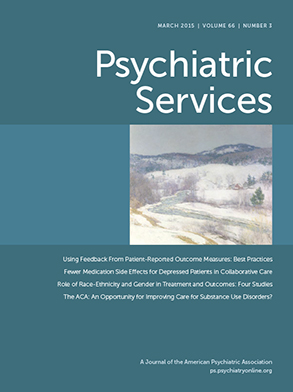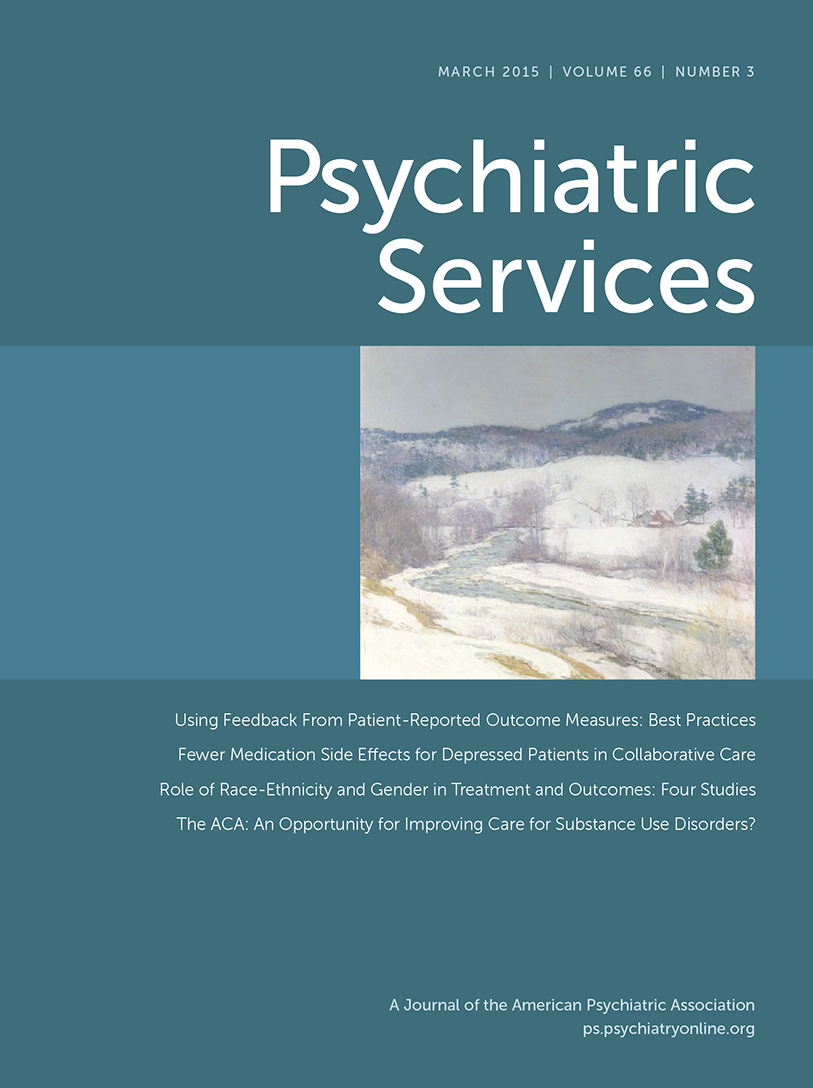Estimates of the prevalence of peripartum depression range from 5% (
1) to 14% (
2) and higher. Suspected negative outcomes are many, including premature delivery and lower levels of newborn attentiveness and emotional expression (
2). Undertreatment has been widely recognized (
3). Obstetric providers have been encouraged to detect depression and to promote access to appropriate care (
2).
To address undertreatment, some states have enacted policies addressing peripartum mental health. Policies might target patient barriers, which include lack of coverage, lack of proximity of an acceptable provider, difficulty obtaining time off from work, stigma, and wariness of psychopharmacologic treatment (
1,
3). Also, a successful policy might address provider barriers, such as reluctance or inability to properly assess mood problems and to provide acceptable interventions to patients in need (
3). Finally, effective policies might address structural aspects of the health care system, including fragmented delivery systems and extension of health insurance access to the uninsured.
This investigation was conducted to identify and summarize policy approaches that have been taken by states, to review evidence of policy effectiveness, and, in the absence of effectiveness evaluation, to evaluate the degree to which any policy might translate into improved mental health. A focus on states is appropriate because states generally hold jurisdiction over health care and are recognized sources of policy innovation.
Methods
The criterion for inclusion as a state peripartum mental health policy was as follows: a state-level legislative code law that is intended to improve detection or treatment of peripartum mental illness. A Web search strategy that used verified, optimal search terms was developed to detect policies. It seemed likely that any state legislative proposal would be noted on at least one Web page, whether by the bill’s sponsor, an advocacy organization, a health care organization, or a news organization. Relevant search results were investigated to resolution: either identification of a state-level legislative code or dismissal as a false positive.
Because a few state policies were already known, likely search terms were tried to determine the fewest search term categories (that is, legislation category and depression category) and the fewest search terms for each category (that is, “mental” and “depressive” for the depression category) that would reliably produce Web search results that included the known policies. Three essential concepts had to be covered by the search terms: depression, the peripartum, and legislation. Although many terms were tried, Web pages addressing the known state policies were identified by Web searches of the name of the state and two terms for each of the three categories: “depression” and “depressive,” “peripartum” and “postpartum,” and “legislation” and “legislative.”
Each term of each pair was crossed with each term of the other two pairs, yielding eight sets of keyword searches for each state (for example, “depressive,” “postpartum,” and “legislation”). In this search development stage, the known state policies emerged within the first 20 Web search results. Therefore, the first 40 results were reviewed for thoroughness. The search was carried out from April 2013 through August 2013. States with pending legislation (such as the failed 2013 New York initiative S.7234) were monitored across this time span, and states with policies were again reviewed in July 2014 to determine whether any subsequent policies had been enacted.
For each identified bill, the state’s legislative tracking resources were used to determine whether it had been enacted. The approaches of enacted policies were analyzed, according to framework analysis methods (
4), to identify categories of policies.
Results
Thirteen states have enacted policies to address peripartum mental health (
Table 1). Analysis yielded four categories: education mandates, by which a woman or family member must receive education regarding peripartum depression; screening mandates, by which health care providers must screen for depression in the peripartum; postpartum depression awareness campaigns to be delivered to the populace generally; and task force mandates, by which a state-level task force or study group is mandated to investigate and report on aspects of peripartum mental health.
States mandating screening include Illinois, Massachusetts, New Jersey, and West Virginia. The three task forces had varied mandates. The 2005 Texas study evaluated the benefit of including postpartum depression as a qualifying condition for Medicaid. West Virginia’s 2006 study evaluated factors, such as maternal health, that contribute to low birth weight and infant death. Oregon’s 2009 task force noted state-level “actions to be taken” regarding “maternal mental health disorders.”
Three of these 13 states later strengthened or expanded a previously enacted policy. Virginia added midwives to those under its education mandate. Minnesota added WIC providers (Special Supplemental Nutrition Program for Women, Infants, and Children) under its education mandate. New Jersey changed the wording of its education and screening mandate from “should” to “shall,” reducing clinical discretion.
Along with these 13 states, two others—Vermont and Illinois—enacted peripartum health care policies that address peripartum psychosocial needs but not peripartum depression specifically. In 1996, Vermont established a task force to address public concern over the increasing practice of hospital discharge within 24 hours after delivery. This led to the state’s 1997 mandate for an evaluation of readiness for postdelivery discharge that includes assessment of “psychosocial” and “emotional” concerns. In Illinois, a 2003 policy mandated a set of reimbursable antepartum care practices, including mental health counseling, to address low birth weight.
Outcomes evidence for each of the four categories was reviewed to estimate the degree to which any policy might be effective. Only one of these policies has been evaluated. For the others, related outcomes data were reviewed to estimate effectiveness.
The impact of New Jersey’s 2006 education and screening mandate was evaluated by using data from the state’s Medicaid program (
5). The portion of women initiating care, indicated by an antidepressant prescription or by the documentation of at least one counseling session, was the same before (6.3%) and after (6.2%) the 2006 policy change. Although this suggests that the mandate had no effect, it is worth noting that the 2006 policy was only a modest change from the 2000 policy.
Several studies that were not policy evaluations indicated the degree to which peripartum depression screening efforts might lead to engagement in mental health treatment for depression detected by screening. Two of these studies were clinical trials intended to treat depression. In the first, only six of approximately 50 women were willing to enroll (
6). In the other, 40% chose to not participate in the study’s structured clinical interview or declined any further study participation (
3).
Two observational studies have assessed the portion of women with positive screens who connect with mental health care. In one of these, despite follow-up monitoring, no women made the link, even though nearly all had employer-sponsored health care coverage (
1). Another study reported outcomes from a depression screening program with low-income women as part of an enhanced Healthy Start program (
7). Only two-thirds accepted a mental health referral, and only 60% of those made at least one mental health visit. Based on this evidence, a state-level depression screening mandate alone is unlikely to address peripartum depression.
Education mandates might increase awareness and so increase detection. Two studies, one a randomized trial (
8) and one a historical-control trial (
9), have tested whether systematically delivered depression education led to greater care seeking by those with elevated depression symptoms. Neither study detected a significant effect.
Ideally, public awareness campaigns would be similar to education mandates: recognition would lead a woman to seek care from a provider. A spouse, friend, coworker, or health care professional who received the campaign messages could encourage the woman to seek care. No outcomes evaluations have been conducted of any of the state-level awareness campaigns. A community awareness intervention to ameliorate postpartum depression was carried out and evaluated in Australia (
10). Sixteen matched communities were randomly assigned to receive the intervention or to serve as a comparison control. Despite the wide array of efforts, depression scores among postpartum women were similar between intervention and comparison communities. A review of depression public awareness campaigns, generally, concluded that the few that had been conducted showed that attitudes can be changed for a modest span of time, and these studies were not able to detect improved clinical outcomes (
11). Therefore, it seems unlikely that public awareness campaigns will achieve desired effects.
Might task forces be effective? Two of the three identified task force mandates led to further actions. West Virginia’s 2006 mandated task force was followed by a 2009 state policy calling for education, screening, and provider reporting of screening activity. Oregon’s 2009 mandated task force was followed in 2010 by a state mandate for a public awareness campaign and in 2011 by an education mandate. Thus task forces are an effective state-level policy avenue for boosting the likelihood of future state-level actions.
Discussion
At least 13 states have enacted policies to address the challenge of peripartum behavioral health needs. These have taken four forms: requiring education regarding peripartum mood disorders, requiring depression screening, state-level task forces, and public awareness campaigns. None of these avenues seems especially effective for addressing barriers to care at the patient, provider, or structural level. The effectiveness of task forces suggests that sustained multistakeholder committees might be an avenue for fostering new initiatives.
What state-level policies might work? Depression education and screening are obvious components of an effective system. Any effective policy will need to address a set of various patient barriers, which may include lack of coverage, the distance to an acceptable provider, difficulty obtaining time off from work, stigma, and possible wariness of psychopharmacological treatments (
1,
3). Also, a successful policy will need to overcome provider barriers, such as provider hesitancy to properly assess mood problems and to provide acceptable interventions to patients in need (
3). Finally, effective policies will need to address structural aspects of the health care system, such as lack of insurance and fragmented delivery systems in which mental health care is separated physically and financially from medical care.
A published review of promising interventions for postpartum depression noted several strategies with efficacy data, including mental health counseling, the collaborative care model of depression, and peer support (
12). Of the various strategies reviewed, the one that might be promoted by a state policy is home visit–based mental health care; states could mandate insurance coverage for a set number of counseling sessions. Postpartum home-visiting nurses have been shown to be effective interventionists for postpartum depression (
13) and also are “accepted” and “accessible,” (
14,
15) overcoming patient and provider barriers.

